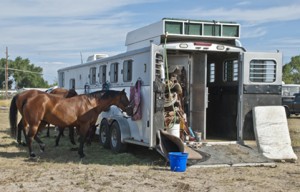Trailer Preparation Tips for Horse Show Travel Season
USRider by: By: Lindsey K. Mulvany
While many of us are currently buried up to our noses in snow, travel season is just around the corner. Before the start of this season, it is critically important for many equine enthusiasts to perform basic, yet essential, maintenance on their trailers. USRider reminds equestrians to invest time doing routine preventive trailer maintenance. This will be time well spent because trailers will be in optimal shape to provide safe travel for precious cargo.
Despite the fact that a good roadside assistance program is something every horse owner should have, the thought of having to use it is never close by. USRider’s mission is to continually educate horse owners about trailer safety as well as keeping you and your equine partner safe on the road.
On its website, USRider has carefully developed the Equine TRAVEL SAFETY Area to be a resource with helpful and practical topics – all free and available to members and non-members alike. Horse owners can put these tips to work and greatly reduce the chances of being stranded on the side of the road.
Some helpful tips from USRider:
- Remove and inspect all wheels and hubs or brake drums.
- Inspect suspension for wear.
- Check tightness of hanger bolt, shackle bolt and U-bolt nuts per recommended torque values.
- Check brake linings, brake drums and armature faces for excessive wear or scoring.
- Check brake magnetic coil with an ohmmeter. The magnetic coil should check 3.2 ohms (+/- 0.3ohms). If shorted or out of tolerance, replace.
- Lubricate all brake moving parts, using a high temperature brake lubricant.
- Remove any rust from braking surface and armature surface of drums.
- Inspect oil or grease seals for wear or nicks. Replace if necessary.
- Inspect and grease wheel bearings.
In addition to these recommendations, USRider advises horse owners to check all trailer tires, (including spares) for signs of dry rot, correct air pressure, faulty air valves, uneven tire wear, overall tire wear and damage. Invest in a high-quality air pressure gauge – learn how to use it – and inspect tire pressure before each trip. Always replace tires if worn or damaged. In addition, tires should be replaced every three to five years regardless of mileage. When replacing tires, always replace the valve stems. Only high quality tires specifically designed and rated for trailers should be used – never use retread or automobile tires on a horse trailer. Think of it this way: Quality tires are like fine leather shoes, they only hurt once – when you pay for them.
It is also important to service the wheel bearings annually, or every 12,000 miles, regardless of mileage, due to moisture build-up. Keep a spare set of wheel bearings in your trailer in case of premature failure. Be sure to inspect trailer wiring and lighting; inspect door latches and grease the doors; inspect the floor (be sure to remove any rubber mats so the entire floor can be examined); and inspect and lubricate mechanical moving parts, such as the hitch and suspension parts. If the trailer has been sitting for a while, check for wasp nests, spider webs and any other creatures that may have made a new home.
USRider advises horse owners to use ICE – In Case of Emergency. This important initiative was designed to aid emergency responders in identifying victims and determining who needs to be notified. Implementing ICE is easy. Program your emergency contact information into your cellular phone and designate it with the acronym ICE.
Horse owners should also ensure that their emergency contact information is stored in their tow vehicle. To facilitate this, USRider has developed an In Case of Emergency form and posted it online for horse owners to print. Simply fill in the blanks and store the paper in the tow vehicle as well as in the trailer. Additional recommendations, as well as a Power of Attorney form, are posted on the USRider website.
USRider – in its 14th year of operation – is the only company to provide emergency roadside assistance for horse owners. Through the Equestrian Motor Plan, USRider provides nationwide roadside assistance and towing services along with other travel-related benefits to its Members. The plan includes standard features such as flat-tire repair, battery assistance, lockout services, and roadside repairs for tow vehicles and trailers with horses, plus towing up to 100 miles. As an additional service, USRider maintains a national database that includes emergency stabling, veterinary and farrier referrals.
For more information about the USRider Equestrian Motor Plan, visit www.usrider.org online or call (800) 844-1409. For additional safety and travel tips, visit the Equine Travel Safety Area on the USRider website at www.usrider.org.
About the Equine Network
The Equine Network provides, creates, and distributes relevant content and services to passionate horse enthusiasts while connecting them to each other and the marketplace. The Equine Network is the publisher of award-winning magazines: Horse & Rider, EQUUS, Dressage Today, The Trail Rider, Spin to Win Rodeo, American Cowboy, Practical Horseman, and Horse Journal. The Equine Network also publishes a proprietary line of books and DVDs for sale through its store, HorseBooksEtc.com. The Equine Network provides emergency roadside assistance through its acquisition of USRider, and is home to several websites including: EquiSearch.com, Equine.com, MyHorseDaily.com, DiscoverHorses.com, Horse-Journal.com, and AmericanCowboy.com











